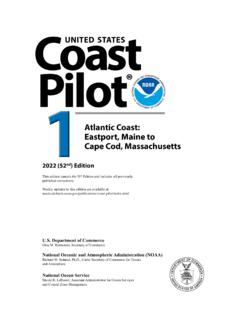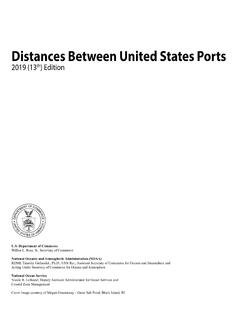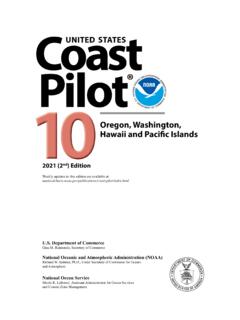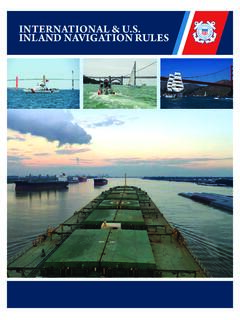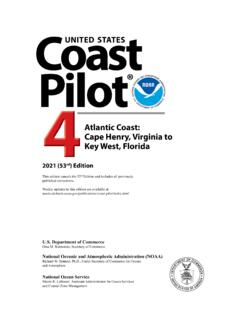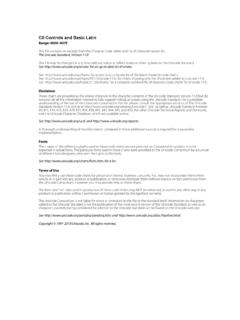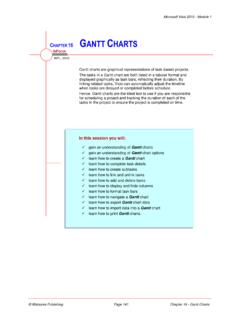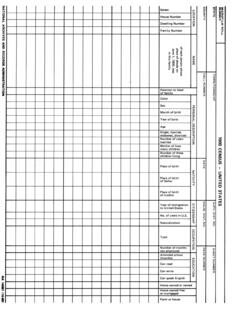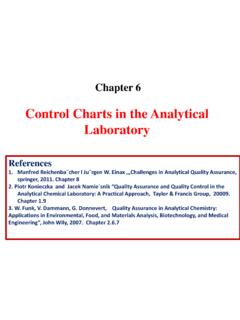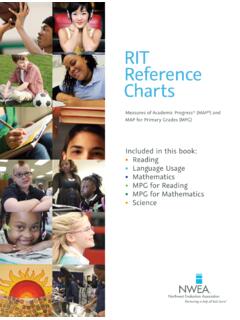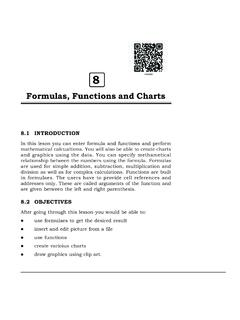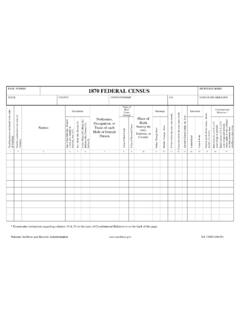Transcription of U.S. Chart No. 1
1 Chart No. 1 Symbols, Abbreviations and Terms used on Paper and Electronic Navigational Charts 13th Edition April 15, 2019 Prepared Jointly by Department of Commerce National Oceanic and Atmospheric Administration Department of Defense National Geospatial-Intelligence Agency ECDIS Symbols and Other ECDIS Information Symbology for displaying Electronic Navigational Charts (ENCs) on Electronic Chart Display and Information Systems (ECDIS) has been added to Chart No. 1. In addition to the ECDIS symbols shown in the traditional lettered sections of Chart No. 1, there are now several special pages devoted exclusively to providing important details about ECDIS.
2 These pages are distinguished by the ECDIS icon, as shown in the top left corner of this page. The ECDIS pages are also listed in the table of contents in italic type. One major difference in the use of paper charts and ENCs is the ability of ECDIS to display the same feature differently depending on user settings and other conditions, such as a ship s draft. An important example is that ECDIS displays wrecks, rocks and other obstructions with their traditional paper Chart symbols if they are at or deeper than the depth of the safety contour set for the ship. Dangers that are shoaler are portrayed with the unique ECDIS isolated danger symbol shown at left.
3 (See the ECDIS Portrayal of Depths page for more information about the ECDIS safety contour.) Another advantage that ECDIS provides over paper charts is enabling users to obtain more information about a feature through a cursor pick. Some feature attribute values that can be obtained by cursor pick are noted throughout Chart No. 1. This is especially true if a particular value, such as height, vertical clearance or the like is included in the INT symbol description. The cursor pick icon, shown at left, is used to indicate when a reference to a cursor pick is made. 7 KHUH DUH PDQ\ RWKHU DWWULEXWH YDOXHV WKDW XVHUV PD\ REWDLQ WKURXJK D FXUVRU SLFN WKDW DUH QRW VSHFL FDOO\ QRWHG 7 KHVH LQFOXGH EXW DUH QRW OLPLWHG WR WKH purpose, seasonality, periodicity, status, color, height, type of structure and the visual or radar conspicuousness of features; shape, color or color pattern of buoys; characteristics of lights; category of obstructions and wrecks; radar wave length, radio frequency, communication channel and call signs; the presence of AIS transmitted signals; information regarding pilotage services and many more.
4 Chart No. 1 is a handy guide for ECDIS users, but it is no substitute for mandated ECDIS training. The ECDIS user and developer communities are invited to help improve the presentation of ECDIS symbology and information in Chart No. 1. Please let us know what additional information you would like to see in the next edition. Corrections, comments, or questions regarding Chart No. 1 may be submitted through ASSIST, the NOAA Coast Survey stakeholder engagement and feedback website at , or mailed to: National Ocean Service, NOAA (N/CS2) Attention: Chart No. 1 1315 East West Highway Silver Spring, MD 20912-3282 2 SYMBOLS, ABBREVIATIONS AND TERMS Contents Document Sections and ECDIS Pages Introduction 5 Schematic Layout 8 Day, Dusk and Night Color Palettes 9 Conspicuous and Non-Conspicuous Features 28 ECDIS Portrayal of Depths 47 Examples of Routing Measures in ECDIS 69 6 LPSOL HG DQG 7 UDGLWLRQDO 3 DSHU &KDUW 6\PEROV 90 Index of Abbreviations 111 Index 117 Appendix 1, IALA Maritime Buoyage System 128 Symbol Sections GENERAL A Chart number , Title, Marginal Notes B Positions, Distances, Directions.
5 Compass TOPOGRAPHY C Natural Features D Cultural Features E Landmarks F Ports G (Not currently used) HYDROGRAPHY H Tides, Currents I Depths J Nature of the Seabed K Rocks, Wrecks, Obstructions, Aquaculture L Offshore Installations M Tracks, Routes N Areas, Limits O (Not currently used) NAVIGATION AIDS AND SERVICES P Lights Q Buoys, Beacons R Fog Signals S Radar, Radio, Satellite Navigation Systems T Services U Small Craft (Leisure) Facilities 3 4 INTRODUCTION Two Symbology Types Comprising Four Symbology Sets Chart No. 1 presents two types of symbology used for marine navigation the symbols used on paper nautical charts (and their digital raster image equivalents) and the corresponding symbols used to portray Electronic Navigational Chart (ENC) data on Electronic Chart Display and Information Systems (ECDIS).
6 Within these two types, four separate symbology sets are shown. These are described below: 3 DSHU &KDUW 6\PEROV INT 7KH LQWHUQDWLRQDO RU ,17 V\PEROV VSHFL HG LQ WKH Regulations IRU ,QWHUQDWLRQDO ,17 &KDUWV DQG &KDUW 6 SHFL FDWLRQV RI WKH ,+2 (International Hydrographic Organization). These symbols are used by many countries around the world, including the United States. NOAA Symbols used on charts produced by the National Oceanic and Atmospheric Administration (NOAA) when an INT symbol is not used. NOAA produces nautical charts for all waters, including the Great Lakes and Territories. NGA Symbols used on charts produced by the National Geospatial-Intelligence Agency (NGA) when an INT symbol is not used.
7 NGA produces nautical charts for the military and for areas outside of waters. (&',6 6\PEROV ECDIS Symbols used to portray ENCs on ECDIS navigation systems. Use of ECDIS is required for large commercial ships on international YR\DJHV 7 KHVH V\PEROV DUH VSHFL HG LQ ,+2 6 SHFL FDWLRQV IRU &KDUW Content and Display Aspects of ECDIS. Other Non-ECDIS Digital Displays May Portray Data Differently 1 DYLJDWLRQ V\VWHPV FHUWL HG WR PHHW WKH H[DFWLQJ SHUIRUPDQFH VWDQGDUGV HVWDEOLVKHG by the International Maritime Organization (IMO) are said to be ECDIS type approved. The symbology used to display ENCs or other non-ENC navigational data on non-ECDIS systems, such as geographic information systems, recreational GPS DQG RWKHU FKDUW GLVSOD\ V\VWHPV FDQ GLIIHU VLJQL FDQWO\ IURP WKH V\PERORJ\ VSHFL HG for ECDIS type approved systems.)]
8 Chart No. 1 only shows the symbology used on ECDIS. Chart No. 1 and Typical Chart Layouts A brief description of the columns on each symbol description page is provided here. A detailed schematic layout of Chart No. 1 is on page 8. Section A, on pages 10 and 11 presents schematics showing typical layouts of the major elements of NOAA and NGA charts. Col 1 Symbol number . The number together with the section letter which DSSHDUV DW WKH WRS RI HDFK SDJH FRQVWLWXWHV D XQLTXH LGHQWL HU IRU HDFK symbol, such as C1 for the Coastline, surveyed symbol. Col 2 INT symbol example. Col 3 Description of the feature or real world phenomenon being portrayed.
9 Col 4 NOAA symbol example. This column will be blank if NOAA uses the INT symbol shown in column 2. Col 5 NGA symbol example. This column will be blank if NGA uses the INT symbol shown in column 2. If columns 4 and 5 are combined, then NOAA and NGA both use the same symbol, which is different from the INT symbol. Col 6 Other NGA symbol examples. NGA produces facsimiles of some foreign charts. If the depiction on the Chart is different than the INT or NGA symbols (shown in Cols 2 and 5, respectively) then the additional foreign symbols are shown here. Col 7 ECDIS symbol example in the day color palettes.
10 (See page 9 for a description of ECDIS color palettes.) Col 8 The ECDIS description usually provides the generic symbol name given in the ,+2 6 SHFL FDWLRQV IRU &KDUW &RQWHQW DQG 'LVSOD\ $VSHFWV RI ECDIS, although sometimes other clarifying terms are also provided. The schematic layout on page 7 shows a typical symbol table page and provides more details about the table headers and the types of information presented in each of the columns. 5 INFORMATION ON SELECTED Chart FEATURES Soundings The sounding datum reference is stated in the Chart title. Soundings on NOAA and NGA charts may be shown in fathoms, feet, fathoms and feet, fathoms and fractions, or meters and decimeters.


